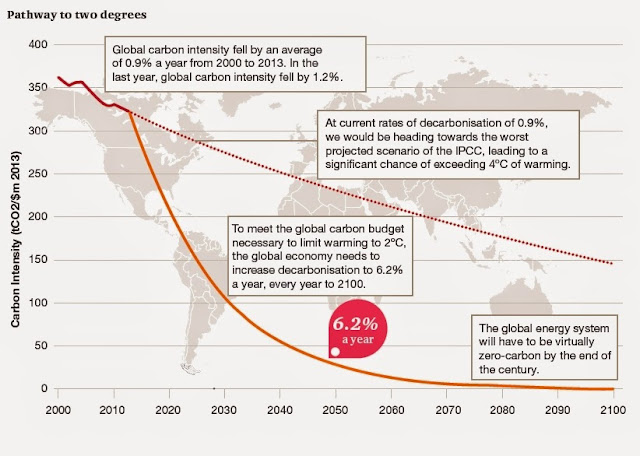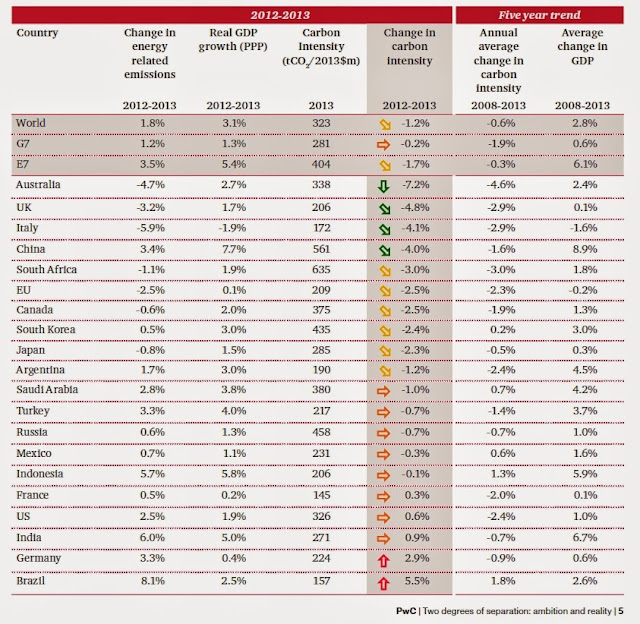World on track for dangerous global warming this century warns PriceWaterhouseCoopers

But there are small glimers of climate hope from the continued growth in renewables and in the reduction in carbon intensity reported by some countries.
However, even if all current policies on the table were fully implemented at their highest ambition range, the planet would still be on a trajectory of at least 3 degrees warming by the end of the century.
The growth in absolute emissions did slow in 2013 - to an 1.8 per cent increase, but we actually need to be reducing absolute emissions. Global emissions are currently about 30 GtCO2 per year and still rising. Our carbon budget to meet a 2 degree target as calculated by the IPCC requires cumulative fossil fuel CO2 emissions between 2010 and 2100 to be no more than 270GtC (or around 990GtCO2). We are on target to blow the global carbon budget in the next 20 years unless we rapidly reign in emissions.
Emission reduction is also measured as carbon intensity, or emissions per unit of GDP which indicates the rate of decarbonisation or decoupling of emissions growth from GDP or economic growth. Global carbon intensity reduced by 1.2 per cent in 2013, slightly better than the average decrease of 0.9 per cent since 2000. But to achieve the level of decarbonisation required to meet the climate target the global economy needed to cut its carbon intensity by 6.0 per cent a year.
This is at least the sixth successive year the world has failed to reduce carbon intensity by the necessary amount. The target per year is now at 6.2 per cent carbon intensity reduction if we are to stabilise the climate at 2 degrees Celsius.
Why is 2 degrees important? This arbitrary limit was set as beyond which the danger of catastrophic climate change impacts and passing tipping points in the climate system become much more likely. Indeed, many scientists argue that we may be very close or past climate tipping points already and that 2 degrees is too high a target. We are already experiencing a huge increase in chaotic and damaging weather with the global temperature rise of less than 1 degree Celsius. Continuing on our current trajectory will have severe consequences for ecosystems, livelihoods and economies according to the 2012 World Bank report Turn Down the Heat (See Climate meltdown: Global Warming heading towards 6 degrees C warns World Bank, November 2012) which stated in the executive summary:
Thus, given that uncertainty remains about the full nature and scale of impacts, there is also no certainty that adaptation to a 4°C world is possible. A 4°C world is likely to be one in which communities, cities and countries would experience severe disruptions, damage, and dislocation, with many of these risks spread unequally. It is likely that the poor will suffer most and the global community could become more fractured, and unequal than today. The projected 4°C warming simply must not be allowed to occur--the heat must be turned down. Only early, cooperative, international actions can make that happen.
Australia leads world decarbonising by 7.2 per cent in 2013
The report reveals a surprising result for Australia. The country achieved a rate of decarbonisation of 7.2 per cent in 2013, an outstanding achievement and showing what can be done through multiple policy channels at reducing emissions while still achieving real GDP growth of 2.7 per cent.
In analysing the results from Australia the report said, and I quote in full:
Australia’s 7.2% decarbonisation rate, topping the tables, is partly driven by a fall in energy demand of 1.7% against a growing economy, mostly attributed to the fall in net energy consumption in electricity generation1. The Australian Renewable Energy target (20% of electricity from renewable sources by 2020) has played an important role in promoting renewables in recent years. The introduction of the carbon tax in 2012 meanwhile coincided with falling energy use (a decline in the iron and steel sector), and an increase in solar, wind and biomass electricity generation in the last two years. There was also a 30% increase in hydroelectric power due to unusually high rainfall in South East Australia and the improved relative cost of hydroelectric power under the carbon price. Looking to the future, just as it may be premature to attribute the impact on emissions to the carbon tax, it remains to be seen how much the decision by Australia’s new parliament to repeal the tax will affect Australia’s future carbon emissions profile. Emission trends beyond energy, for example fugitive emissions from oil and gas and coal mining, and agricultural emissions, are also likely to play important roles in Australia’s decarbonisation pathways.
Many of these policies have now been overturned by the Abbott government including abolishing carbon pricing that had been operating for two years from July 2012, abolishing the large scale energy efficiency program, and creating an unstable investment environment for renewables through it's attacks on Australian Renewable Energy Agency (ARENA), the Clean Energy Finance Corporation (CEFC) and the Warburton review of the Renewable Energy Target which recommended scaling back the target. We are already seeing a slight rise in emissions from the energy sector, the first for several years.
Slow Reduction in carbon intensity globally
Other countries achieved decarbonisation rates of between 4 and 5 per cent included the United Kingdom, Italy and China, but there was also an increase in carbon intensity from France, the US, India, Germany and Brazil.
While the Carbon intensity of the G7 developed economies in total (Canada, France, Germany, Italy, Japan, United Kingdom, United States) was relatively flat in 2013 reducing only 0.2 per cent, the E7 emerging economies (China, India, Brazil, Mexico, Russia, Indonesia, Turkey) have reduced carbon intensity in total by 1.7 per cent. This provides a glimmer of hope that more rapid decarbonisation may be possible as these developing economies are now responsible for much of the world's energy intensive manufacturing.
According to the PwC report as a group the G7 countries to meet their 2020 carbon targets or Cancun pledges, "needs to reduce carbon intensity by 3.8% a year between 2013 and 2020". To meet 2030 and 2050 targets a reduction of 5.9% annual carbon intensity reduction between 2020 and 2050 is required, according to the report.
For the E7 group of countries carbon intensity to meet 2020 targets needs to fall by 4.2 per cent a year. Absolute emissions need to peak before 2020 and start to fall if we are to stay on track for a 2 degree target.
"Assuming the 2020 targets can be achieved, we would expect to see for the E7 group an 8.5% annual carbon intensity reduction between 2020 and 2030 and then further 5.3% annual reduction until 2050." says the report.
India's coal boom being supplanted by renewables
In 2013 India's carbon intensity increased by 0.9 per cent with coal consumption rising as domestic demand surged, with local coal mining being supplemented by imported coal, while the growth in renewables has lagged more developed countries. But this is all changing.
India is already poised to become a solar leader although Coal currently produces 70 per cent of India's electricity. The election of the conservative Narendra Modi government in 2014 has also seen a suite of initiatives for solar energy across the country and a doubling of the tax on coal which will reduce India's carbon intensity in future years. The rollout of solar power is planned to enable every home to run at least one light bulb by 2019, according to a Bloomberg report.
The indirect effect of India's solar revolution may be to strand development of the Galilee basin coal mines in central Queensland, Australia (Australia's coal expansion risks stranded assets, December 2013). Two Indian coal and energy companies - Adani and GVK - have investments in coal resources in the Galilee basin at risk of being uneconomic to develop. Gina Rinehart's Hancock Prospecting has already granted an open-ended extension for GVK to raise $US560 million tranche to complete the $US1.26 billion purchase of 3 Galilee basin coal mines: the Kevin's Corner mine and a 79 per cent stake in two neighbouring mines, Alpha and Alpha West mines. Adani's coal investments have also been labelled as 'not commercially viable'.
China reducing carbon intensity but still below own targets
Total carbon emissions from E7 countries is 1.5 times larger than the G7, with China being the single biggest carbon emitting country. China was able to improve it's energy intensity by 3 per cent in 2013 achieving a 4 per cent carbon intensity reduction while still achieving real GDP growth of 7.7 per cent.
Although positive, this improvement falls short of its own official target of 16% energy intensity improvements over the five year plan 2010-2015. The report notes that "The country will need to make up for lost ground through major energy efficiency improvements in 2014 and 2015. Towards this goal, early indicators for 2014 suggest that in the first half of the year China has recorded a 4.2% fall in energy intensity, chiefly through tougher government measures addressing coal use, and an increasing share of services within its economy."
Contributing to China's energy efficiency and carbon intensity reduction is a flourishing renewables sector and introduction in the past year of seven regional emissions trading schemes, with China's national ETS expected to be launched in 2018.
While China's coal use rose 3.7 per cent in 2013, there are signs this may soon peak. There is substantial concern over pollution levels and the impact on population health in China which is also driving a curbing of coal use with a limit on coal use restricted to 65% of its energy mix already in place, and a proposed ban on coal-fired power in the Beijing region by 2020.
Growth continues in Renewables
Renewables grew in 2013 at 16 per cent continuing a trend of double digit growth over the last decade, but this growth is coming from a small base. Renewables now represent about 22% of the global electricity mix based upon current IEA data, however it's share of total energy mix remains small at about 2.2 per cent (8.9 per cent with hydroelectricity).
The high growth in renewables has been offset by moderate growth in coal and gas-fired generation, particularly in some E7 countries, and also the heavy reliance on fossil fuels in transport and energy intensive industrial processes such as the chemical and steel industries.
The report highlights the positive signs for renewables with investment in power generation in OECD countries rising from 14 per cent in 2000 to over 60 per cent in 2012. Developing countries lag behind with 19 per cent investment, but with signs this is changing with major development finance instutions reducing loan funding for coal and gas.
Divestment campaigns are also starting to bite with universities such as Stanford and major superannuation funds like HESTA restricting or disinvesting from high carbon assets like thermal coal. (See also Your Superannuation is Destroying the Planet - John Hewson fights back on climate, September 2014)
There are also some hurdles to be overcome in managing the transition to renewables, including how to manage intermittency and energy storage, and transitioning transportation systems and industrial processes.
The 50-state plan to transform U.S. to renewable energy outlined by Professor Mark Jacobson from Stanford university provides roadmap answers to these questions and shows that the US could transition to 100 per cent renewable energy economy by 2050, including converting transportation through adoption and rollout of electric and hydrogen cell vehicles.
"The new map provides all of the basic information, such as how many wind turbines and solar panels would be needed to power each state, how much land area would be required, what would be the cost and cost savings, how many jobs would be created, and how much pollution-related mortality and global-warming emissions would be avoided," Jacobson said in a media statement. You can see a State by State breakdown of what this would entail at the Solutions Project.
Earlier work by Jacobson and colleagues showed that it would be feasible to achieve a carbon neutral solar and wind powered world in 20 to 40 years if political and social will were brought to bear along with the necessary resources.
Similarly in Australia Professor Mark Deisendorf and colleagues have demonstrated that Baseload power is a myth: even intermittent renewables will work, based upon extensive modelling of hour by hour electricity consumption with observed meterorological data for citing wind farms and solar power stations as part of the National Electricity Market (NEM) grid. Beyond Zero Emissions showed in their groundbreaking report launched in 2010 that it would be possible to convert Australia's stationary energy production to 100 per cent renewables and zero carbon emissions within the space of a decade.
Climate talks on the road to a Paris climate agreement
The inaction by political leaders for over 20 years now means the timeline for taking action is tight and needs to involve rapid and substantive changes.
Hence the importance of the Climate Summit in New York on 23 September which will have at least 125 heads of state attending. United Nations Secretary general Ban Ki-moon explained that "Action on climate change is urgent. The more we delay, the more we will pay in lives and in money. The Climate Summit that I am convening one week from today has two goals: to mobilize political will for a universal and meaningful climate agreement next year in Paris; and second to generate ambitious steps to reduce greenhouse gas emissions and strengthen resilience. We are anticipating an impressive turnout of leaders from Government, business, finance and civil society. Most important, we are expecting significant commitments and progress." he said in a media statement.
Ban Ki-moon also made the unusual announcement of his presence at the People's climate march in New York scheduled for Sunday:
"I will link arms with those marching for climate action. We stand with them on the right side of this key issue for our common future."
This special UN meeting is a leadup to the UN Climate talks in Lima, Peru (COP20) in December, and the UN climate talks in Paris (COP21) in December 2015 where a global agreement is scheduled to be signed.
There is also the G20 meeting in Brisbane on 15-16 November which Australian Prime Minister has so far refused to have climate change on the agenda. The PriceWaterhouseCoopers report outlined the critical nature of the G20 nations taking substantive action to reduce greenhouse gas emissions:
In 2013, the G20 economies made up about 85% of global energy-related emissions. Their role in reducing emissions will fundamentally determine whether we are successful in tackling emissions growth at the global scale. This does not diminish the vital role of other countries’ actions on emissions: all countries will need to work together towards zero net carbon globally by 2100, but the G20 are critical in determining the carbon pathway.
The PriceWaterhouseCoopers report highlights the need for continued action in reducing emissions including:
- reducing subsidies to fossil fuels in all the various forms as advocated by the IEA since 2011,
- cutting pollution from fossil fuel power stations such as through the US Clean Power Plan and the efforts in China in limiting the import of thermal coal,
- placing a carbon price on coal and gas through carbon taxes or emissions trading schemes,
- the use of energy efficiency programs to reduce demand, and
- continued rapid development and rollout of renewables for power generation.
Sources
- PricewaterhouseCoopers, September 2014 - Two degrees of separation: ambition and reality Low Carbon Economy Index 2014
Takver is a citizen journalist from Melbourne Australia who has been writing on climate change, science and protests since 2004.
Get Involved
If you'd like to help with maintaining or developing the website, contact us.
Publish
Publish your stories and upcoming events on Indybay.




